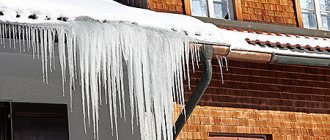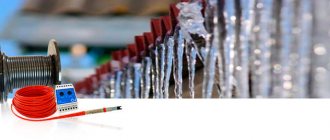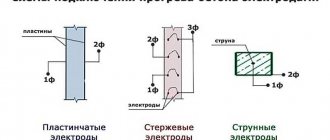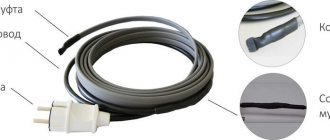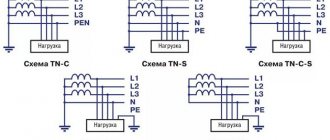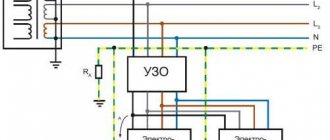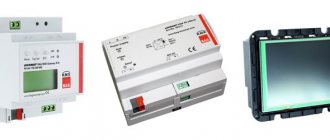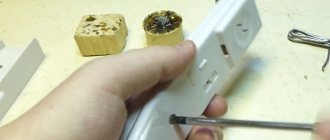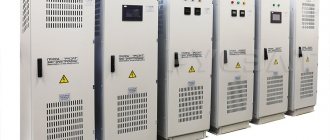Snowballs falling from the roof and falling icicles destroy drainage systems, damage property and threaten people walking under the house. Heating the gutters and roof will help get rid of these troubles. How to install it correctly? What problems can it solve? And is it safe? Let's figure it out within the framework of this article.
Heating of gutters and roofing (photo No. 1)
Frost, snow and sudden temperature changes above and below 0 degrees are harsh conditions for finishing the facade, roofing and all materials intended for outdoor use. What can happen to the roof?
- Snow falling from the roof can collapse the gutters, installed air conditioners, and damage the cladding of the house.
- Snow slides and icicles can pose a threat to the health and lives of people who pass under the house.
- With a slight thaw, the snow melts, and during the next frost it becomes ice in the drainpipes and gutters, expands and can cause damage.
Heating the roof will help solve the first two problems. The third will be solved by heating the drainage system. But in most cases, the problem must be solved comprehensively by installing an anti-icing system - heating the roof and gutters.
What is roof and gutter heating and how does it work?
A de-icing system is a heating cable installed on the roof and in gutters to melt snow and ice. It allows you to avoid physically cleaning the roof, gutters and pipes, which is often difficult, inconvenient, dangerous and can lead to damage to roofing materials and gutters.
Heating cable installed to heat the roof (photo No. 2)
If the system is installed incorrectly, for example, there is no heating of the gutters, the problem will not be solved. Meltwater will freeze again, causing damage to gutters, downspouts, gutters and downspouts.
Therefore, in most cases the heating cable is pulled:
- along the edge of the cornices,
- in the valleys,
- at all roof joints,
- in the gutters of the drainage system,
- in funnels and drainpipes,
- in drips,
- in drainage trays.
Heating zones for the roof and drainage system. (photo No. 3)
It is not necessary to place the cable in all of the listed places. Sometimes it is enough to lay only a cable to heat the gutters:
- the roof is “cold”, that is, there is an unheated attic underneath it, so the temperature on the roof surface is not higher than the air temperature, which means ice does not form on it;
- the building is low, there are no gutters or walkways underneath it—snow melting won’t do any harm;
- high-quality thermal insulation of the roof has been laid - in fact, if there is no heat loss from under the roof, the roof will also be cold.
For each house, the heating system for the roof and gutters is calculated individually. The calculations are influenced by the size, shape of the roof, the angle of the slope, the presence of architectural elements that can trap snow on the roof, pedestrian paths along them and other factors.
Let's look at a few examples.
1. The roof slope is steep, snow can fall like an avalanche. To avoid consequences, you need to install snow guards. A heating cable is laid between them and the cornice. This should be done with a snake (zigzag with rounded corners). The height of the snake wave, depending on the location of the snow retainers, ranges from 35 to 100 cm.
The cable is laid between the snow guard and the edge of the roof. (photo No. 4)
2. If the roof is flat, the drainage system is installed inside the building. The heating cable is laid out like a snake around the water inlet. The area of such a snake can be about 1 square. m.
The cable is then inserted into the drain. There is no point in warming it up completely - the temperature inside the building is above zero, and the snow will melt naturally. As a rule, a heated drain is made up to 1 m deep.
A simple diagram of the operation of a heating system, which consists of one thermostat, will look something like this.
The thermostat sets the required temperature, for example, 0 degrees or −1 degree. When the air temperature drops to this level, the heating system for gutters and roofing starts automatically.
However, it often happens that the temperature outside is below zero, but there is no snow. In order not to overheat the system, instead of a temperature detector, you can install a comprehensive weather station that evaluates temperature, the presence of snow and humidity levels.
Causes of ice on the roof
“Temperature swings” inevitably lead to the formation of ice. This is the name for weather with temperatures changing from plus to minus at least once a day. In late autumn, early spring and even winter this happens regularly. The snow on the roof melts slightly and sticks together, forming the so-called “firn”, and then pieces of ice. The gutters become clogged to the top, water overflows and now a bunch of icicles are hanging from the roof.
Where does ice accumulate the most?
The coldest place on the roof is its edge, which protrudes beyond the wall of the house. Gutters are usually laid there to collect rainwater and drain it through funnels and downpipes to ground level. Ice forms and accumulates here, on the edge of the roof and in the drainage system.
Why is roof icing dangerous?
Ice, with its weight, deforms the roof, bends and breaks gutters. Iced gutters no longer fulfill their purpose; ice covers them inside and out, the brackets cannot withstand and break off. Blocks of ice fall down, breaking wires and breaking windows. In cities, ice floes crush cars in parking lots and kill bystanders.
In country houses and estates, icicles can cause serious injuries to the inhabitants, destroy the roof and break objects located near the house. Some homeowners park their cars next to their houses - is it necessary to talk about what can happen to the car after an icicle or ice floe hits it? Anti-icing is one of the most important tasks for owners of private cottages and summer cottages. And there's only one way to avoid this task becoming an annual headache.
Ice deforms the roof with its weight. Photo: globallookpress
Selection of anti-ice system
The system is based on a heating wire.
This is a special cable for heating roofs and gutters. The one used in underfloor heating systems cannot be used on the roof. !
To heat the roof you need a special cable. The one used in underfloor heating systems will not work.
For the roof, a cable is used that:
- has a special polymer shell;
- UV resistant;
- waterproof;
- resistant to harsh climatic conditions: negative temperatures, their sharp fluctuations, etc.;
- resistant to mechanical damage, including hail.
A high-quality cable will last up to 10 years.
To heat the roof of private houses, you can use two types of heating cable:
- Resistive (also known as constant power cable) is an economical, easy to use, durable option.
Under its shell there is a conductor with high resistance. When it is energized, its temperature increases and the cable loses heat to the environment. A resistive wire has a constant resistance along its entire length, the sections have a standard length, so it is important to select it correctly according to the required parameters.
Features of the structure of a resistive type cable. (photo No. 5)
Separately, it is necessary to highlight the zonal resistive cable, the heating filament of which is made of chromium. It can be cut.
- Self-regulating cable produces different amounts of heat under different environmental conditions.
Inside it are 2 wires and a matrix that changes their resistance: the higher the air temperature around the wire, the less it heats up; The lower it is, the stronger the heating. This avoids overheating of the wire. You can do without temperature control equipment. And the cable itself can be cut into pieces of the required length (from 20 cm).
Features of the structure of a self-regulating cable. (photo No. 6)
The advantages of different types of cable are summarized in the table below.
| Advantages | Resistive cable | Self-regulating cable |
| Cable price | + | |
| Easy to install | + | |
| Life time | + | |
| Fire safety | + | |
| Price of the system as a whole | + |
Table 1. Advantages of resistive and self-regulating cables.
!
Resistive cable is cheaper, easier to install and will last longer. A self-regulating wire will last less, but it allows you to do without temperature control devices, which ultimately reduces the cost of the heating system as a whole.
Types of heating cables
The main element of the anti-icing system is available in several variations.
Resistive heating cable
Although the definition of “resistive” for this type of cable is firmly established, it is not entirely correct. It would be more correct to call this cable option “unregulated”, since all heating cables are resistive in nature.
An unregulated cable has the simplest design. This is an elongated heating element made of a metal alloy with high electrical resistance (usually nichrome is used), enclosed in a shielding shell and insulation. Its advantages are the following:
- has low cost;
- during switching on it does not cause a significant jump in current (the so-called inrush current).
Resistive cable is easy to connect and inexpensive, but it uses electrical energy inefficiently
Flaws:
- Has constant heat output. Because of this, those areas of the roof that currently need less heat are subject to overheating, and even at the expense of the user (overconsumption of electricity). In addition, if there is insufficient heat dissipation, an unregulated cable may overheat and burn out. Particularly susceptible to overheating are the areas where two cable lines overlap.
- It is impossible to shorten the length of the cable in an already installed system, since this will reduce its electrical resistance and, accordingly, increase the current strength in the circuit.
- The linear power also depends on the length.
- If the heating core breaks, the entire cable becomes inoperable.
The unregulated resistive cable is available in two versions:
- single-core;
- two-wire.
In fact, a two-core cable also uses one core, only it is folded in half. This allowed us to win the following:
- There is no longer any need to close the circuit by pulling the other end to the connection point. Thus, the two-core cable is laid in one thread, and not in two, like a single-core cable, therefore, the danger of overlap when large masses of snow converges is eliminated. It should also be noted that a system with such a cable is simpler to design and install.
- The currents flowing in the cable cores, and essentially in the two halves of one core, have opposite directions, so the magnetic fields they generate cancel each other out. A single-core cable in close proximity to a person (for example, if the attic is residential) can cause harm to health with its electromagnetic field.
Zone resistive cable
The heating core is also made of nichrome, but the cable is designed slightly differently: it consists of two insulated current-carrying wires (phase and zero), and the heating wire is wound on them in the form of a spiral. In this case, the nichrome conductor is divided into segments, which at their ends are connected to the current-carrying conductors. Thus, a zone cable consists of many heating fragments connected to the electrical network in parallel. This provides the following benefits:
- The length of the cable can be reduced, since the current at the input decreases, and the linear power remains constant at any length.
- If the heating core breaks in any place, other areas remain operational.
When the length of a resistive cable decreases, its linear power remains unchanged
A zonal resistive cable, as you might guess, costs more than a regular cable.
Self-regulating cable
This cable, like the zonal one, has two conductive cores, but the heating wire is made of a completely different material: it is a special polymer with semiconductor properties, called a “matrix”. It is laid not around the current-carrying conductors, but between them. The peculiarity of the matrix is that its electrical resistance depends on temperature: the stronger the heating, the fewer current-carrying paths are active.
In the end, when heated to a certain temperature, the polymer generally turns into a dielectric, that is, it turns off, while areas with an acceptable temperature continue to function. The advantages of a self-regulating cable are obvious:
- Burnout in areas of overlap or due to insufficient heat removal is physically impossible.
- If the roof overheats in any place, the corresponding section of the cable automatically reduces the heat generation power, so that electricity is consumed very rationally. As practice has shown, on average, a system based on a self-regulating cable consumes 2 times less electricity than one equipped with an unregulated analogue.
- All current-carrying paths are connected in parallel, so the cable length can be reduced. A matrix break does not lead to cable failure.
- The service life is about 30 years. This is several times (!) more than that of an unregulated cable.
A self-regulating cable is more expensive than a regular cable, but it is much more reliable and economical to operate.
But there are also negative aspects:
- the cost of a self-regulating cable is 3 - 5 times higher than the cost of a non-regulated one (240 - 660 rubles / linear meter versus 90 - 150 rubles / linear meter);
- in a cold state, the matrix has a very low electrical resistance, so when turned on, a high inrush current occurs (more expensive protection devices have to be used).
How many meters of cable are needed to heat the roof and gutters of a house?
To answer this question, you must first decide where and how it will be laid out and what power is needed.
On the roof, the cable is laid in a snake with a loop length of 30 to 60 cm and a distance between loops of 30-40 cm. The pattern is selected in such a way that the power per square meter of heated area is in the range of 200 - 250 W.
To prevent ice build-up in the gutters, 1 or 2 cable strands are installed in them. The choice depends on the diameter of the gutters and the power of the cable itself:
- The radius of the gutters is less than 7.5 cm - one thread with a power of 30 to 40 W/m is enough.
- The radius of the gutters is more than 7.5 cm - use 2 threads with a power of 30-40 W/m each.
Trench with two strands of heating cable. (photo No. 7)
- The minimum power of a heating cable for a roof is 25 W/m. If there is no wire of the required power, more threads are laid to achieve the specified power.
How to lay cables in valleys? It is enough to warm up 65-70% of the valley length. We stretch the cable vertically in both directions, and so that there is at least 1 m left to the overhang. It is important to ensure its power in the range from 250 to 300 W per square meter. m.
!
For the roof and drainage system we use a special heating cable with a power of 25-40 W/m.
Knowing the pattern of cable installation on the roof, as well as the length and required number of threads for heating the drain, you can calculate the length of the cable. It's simple: we calculate the length of the cable for heating each element and add it up.
Our objects also include:
Objects of state significance
- Ministry of Economic Development of Russia;
- Ministry of Defense of the Russian Federation - warehouse roof heating;
- Administrative building of the Presidential Administration;
- FSUE "Communication-Security", st. Delegation;
- Administration building of the city of Uglich;
- Arbitration Court building st. Thatched lodge;
- OKB im. Mikoyan, Moscow.
Office buildings
- Office ;
- Sports complex in Kratovo;
- Institute of Kolomna;
- Administrative and office – heating of the roof and ramp;
- Administrative building on the street. Old Arbat;
- Administrative building Moscow st. Tsvetnoy Boulevard, 22 building 1;
- TOC "Sheremetyevsky" Moscow st. Nikolskaya, 10.
Banks
- JSC "Rosevrobank";
- Interregional Development Bank.
Roof heating in private houses
- Cottage village Nikolina Gora;
- Cottage village Uspenskoye;
- Cottage village Kratovo;
- Cottage village Snegiri;
- Cottage village Gorki-II;
- Cottage village Novospasskoye;
- Cottage village Penaty;
- Cottage village Arkhangelskoye;
- Cottage village Barvikha;
- Cottage community Lesnoy Prostor;
- Cottage village Bykovo;
- Cottage village Pozdnyakovo;
- Serebryany Bor holiday village;
- Cottage L.A. Yakubovich.
Other
- Entertainment club "Metelitsa";
- Turkish Business Center - heating of the roof, ramps, balconies;
- Holiday home "Druzhba";
- Ochakovsky reinforced concrete products;
- Warehouse Chekhov;
- Kirov porcelain factory.
- Prev
- Next
What does the anti-icing system consist of?
To install the anti-ice system we will need the following elements:
- the heating cable itself;
- control panel;
Panel for control equipment. (photo No. 8)
- three-wire power cable (VVG);
- temperature, snow, water sensors - installed on the roof, in gutters and drainpipes to collect data and automate the system;
- cable KVVG for connecting sensors;
- controller or thermostat (minimum temperature range from −8 to +3 degrees; the larger this range, the easier it is to automate the operation of the system);
- protective distribution boxes with degree of protection IP55;
- mounting tape to secure the heating cable;
Mounting tape and method of fixing the cable in it. (photo No. 9)
- galvanized chain or cable;
- sealant;
- modular input circuit breaker with residual current device; as an alternative - a difavtomat with a similar current;
- modular starter;
- three-position switch that allows you to switch between automatic and manual modes;
- thermostat;
- temperature, water and snow sensors;
- circuit breakers.
Operation of anti-icing systems: expert advice
In order for roof heating to function for a long time and without failure, you must comply with the requirements for arranging the system. The rules for operating the system are as follows:
- Before the start of the season, you need to clean the drainpipes and other elements on which the heating cables are located. To do this, use soft brushes. Cleaning is carried out as carefully as possible, since strong mechanical impact can damage the cable.
- It is necessary to periodically inspect the system equipment. For example, connections need to be tightened.
- Automatic switching on/off of the system is determined taking into account the climatic conditions in the region. The manufacturer's recommendations are also taken into account.
Heating of gutters and roofs: installation
All is ready? You can begin installation of roof heating and gutters.
Stage 1. Installation of the heating cable.
➠ Step 1. We measure the heating cable on the ground. We take measurements with mounting tape at a distance of 50 cm from each other. We carry out the appropriate markings on the roof.
➠ Step 2. Measure the length of the cable for heating the gutters. We connect it with a chain or cable.
➠ Step 3. Check the integrity of the heating cable. We measure resistance. We compare the indicators with the data that the manufacturer indicated in the passport.
➠ Step 4. After checking, if the cable is in order, lay it in a snake (zigzag) pattern along the roof slope. It is best to fix the cable using mounting tape glued to the roof with sealant. This way there will be no holes that could cause a leak after some time.
➠ Step 5. We insert the cold end into the installation box, which we install under the ridge.
➠ Step 6. Check the sections for the drainage. We measure the insulation between the grounding protective conductor and the working conductors.
➠ We record the received data in the passport. If the system stops working after a few years, our records will make it easier to find the problem.
➠ Step 7. Clean the gutters and pipes of the drainage system from debris and dirt.
➠ Step 8. We fix the mounting tape inside the gutters. To do this, you can use rivets or fasteners without them. The fastening pitch is 25 cm if the cable is resistive, and 50 cm if it is self-regulating.
➠ Step 9. We lower the vertical section of the wire into the drain pipes using a galvanized chain or cable.
For pipes 4 m or more in length, it is mandatory to use a cable. For shorter pipes and valleys - optional. But it’s better to be safe than sorry. If the system does not work, snow will stick to the cable, increasing the load by an order of magnitude. Without a cable or chain, the cable may break.
If we use a chain, we connect the cable to the links using special spacers.
We pay attention to the “bottlenecks” of the drainage system - funnels and pipe outlets. Sometimes, to prevent ice from forming here, it makes sense to add additional heating.
➠ Step 10. We hang the cable from above on a hook. The top link of the chain is secured to a pin fixed across the hole.
An example of using a chain to support a cable and secure it to a pin placed across a hole. (photo No. 10)
➠ Step 11. We insert the cold ends of the heating cables into the installation box.
➠ Step 12. Repeat the described algorithm on all roof slopes.
➠ Step 13. If there is an extension, for example, a garage, drains are not always installed on it. But you need to protect yourself from snow or icicles. If the garage has a pitched roof, it is heated using the “dripping loop” principle: the loops should extend beyond the edges of the roof by 5-7 cm.
The principle of cable installation is “drip loop”. (photo No. 11)
Stage 2. Connecting automation
System protection equipment (photo No. 12)
➠ Step 14. Install the automatic control system: controller and protective group. The optimal place for this is the switchboard in the house.
➠ Step 15. Install the sensors. In order for the heating system of the roof and gutters to work correctly, we correctly choose where to place them. Snow sensor - on the roof. The water sensor is at the bottom of the gutter.
➠ Step 16. Connect the sensors and the controller.
Equipment connection diagram. (photo No. 13)
➠ Step 17. Install the protective group.
➠ Step 18. Measure the resistance of the cables.
➠ Step 19. Check the operation of the automatic protective shutdown system.
➠ Step 20. If everything works, set the required indicators on the thermostat and turn on the system.
Our advantages
Experience over 15 years Extensive experience in the field of roof heating
Free measurements Our specialist will come to the site free of charge
Full range of services From design to installation and maintenance
Individual approach We offer flexible terms to each client
| To correctly calculate the heating system, please fill out the form and send it to us. Our experts will contact you shortly! | Leave a request for calculation |
Heating the roof, overhangs and drainage system helps avoid the formation of ice and snow accumulation. We use self-regulating cables from the best manufacturers such as Raychem
,
SST
and others. Their use guarantees fast and efficient heating of the entire roofing system.
It should be remembered that the electric heating system is an engineering structure that requires the creation of a project. These types of projects should be developed with the participation of professionals.
What should you not do when installing an anti-ice system?
Due to the apparent simplicity of installing the system, inexperienced workers make common mistakes. And the heating of the roof and gutters does not work correctly, does not work at all, or causes premature death of the drainage system and roof.
We have collected the most common mistakes that anti-icing system installers make.
1. The specifics of the building are not taken into account. The system was installed “like everyone else.” As a result, it turned out to be ineffective. Ice continues to form in some areas.
Which is correct? Preliminarily design a heating system for gutters and roofing.
2. The opposite example: the cable is laid where it is not needed. There will be no harm to the system from this. But these are pointless expenses that you can do without.
Which is correct? Carefully consider the system before installation.
3. The cable was used for heated floors, not for the roof. And it will last much less.
Which is correct? Use a special cable with UV and weather protection.
4. The cable is secured with brackets using self-tapping screws. As a result, the tightness of the roof is broken and a leak forms.
Which is correct? Use fastenings without mechanical damage to roofing materials.
5. The cable is secured with a plastic clamp, not intended for outdoor use. In the sun it will quickly become unusable. This mount will last no more than a year.
Which is correct? Use special fastenings.
6. The cable for heating the drainage system pipes is not secured with a cable or galvanized chain. Under certain circumstances, snow and ice will begin to accumulate on it, and under their weight, sooner or later the cable will break.
Which is correct? Heating of gutters and downspouts is done using a cable or chain.
7. A cable with a power of less than 25 W/m was used. Such a system will not cope with its task.
A clear example of how a low-power heating cable works (photo No. 13)
Which is correct? Select an anti-ice system based on power in accordance with the design characteristics of the roof and gutters.
8. The temperature sensor is located in direct sunlight or near the heating cable. It records an unreliable temperature, and the entire system does not work correctly.
Which is correct? All sensors must be located in the correct place. Temperature detector - in the shade.
9. No drainage system. The roof heating device can still be installed. But snow and ice will melt, flow from the roof along the facade of the house and freeze, forming ice on the finish. When it starts to melt, it may fall off along with the trim.
Heating of industrial buildings
At pumping stations, oil depots, and shipping terminals, complex systems of measuring and process pipelines, tanks, and buildings are installed that need to be heated in cold weather. At oil refineries, freezing of process units, treatment facilities, and transport routes must also not be allowed.
In winter, serious problems arise in the fields when transporting oil, water, gas, and various process fluids. If circulation stops, any compositions, especially highly viscous or waxy oils, freeze and clog the lines. Most often this leads to pipe ruptures. High viscosity is the cause of overloads of pumping units and excessive consumption of electrical energy.
At industrial enterprises it is necessary to install equipment that protects against freezing. Industrial roof heating is used to maintain specified temperatures in containers and pipelines. Using cables, you can protect any devices from damage, including those in hazardous areas. Thanks to this, you will maintain the impeccable quality of petroleum products and various technical fluids. At the same time, the operation of heating tapes will always be safe.
Self-regulating heating cables
Products of the SST PROFI brand, VL, VM, VR, VC, VX series, have a flat shape. The semiconducting matrix is made of materials that change resistance when temperatures change. It is fixed between two conductive wires.
The linear power of each point of the heating tape corresponds to the temperature conditions. This allows you to save energy by preventing overheating at the intersections of cables. The outside of the matrix is covered with a layer of elastomer insulation and braided tinned copper wire. They provide reliable grounding and mechanical strength.
Tapes are used in the following areas:
• food industry; • electric power industry, fuel industry; • ferrous and non-ferrous metallurgy; • chemical and petrochemical industry; • mechanical engineering and metalworking; • forestry, woodworking industry; • farms.
VM cables
with a power of 11 or 17 W/m protect against freezing and maintain the required temperature in small-diameter pipes, small-sized tanks, and process equipment with an operating temperature of no more than +65 °C.
VL cables
have a power of 23 or 27 W/m. They are designed for more intense electrical heating of roofs and gutters than VM. With their help, you can protect pipes with a diameter of up to 10 cm from freezing, compensate for heat loss during the transportation of technical fluids, and warm up industrial installations.
VR cables
suitable for industrial and architectural heating. They have a power of 11, 17, 27 or 31 W/m. Heating tapes help effectively combat icing of elements of industrial structures. The shell is made of elastomer, resistant to water and direct sunlight. The fluoropolymer shell reliably protects against corrosive chemical solutions and vapors. The operating temperature, as in the cases of VM and VL, does not exceed +65 °C.
VC cables
designed for use in harsh conditions. Heating tapes have a power of 17–60 W/m. They operate at temperatures up to +120 °C, without load they can withstand temperatures up to +190 °C. VC cables heat process equipment, pipelines with petroleum products, and prevent the hardening of paraffins. The black fluoropolymer jacket is required for protection in corrosive environments.
VX cables
technical characteristics resemble VC, but have a red shell. It is made from resistant fluoropolymer VX-F for use in chemically aggressive environments: organic solvents, acids, alkalis. Such tapes allow you to build simple and effective roof electric heating systems. They have a wide power range: 10, 30, 45, 60, 95 W/m. The wire does not overheat and does not burn out even if it crosses itself.
Other industrial system components
Thermostats compensate for heat loss and optimize heating power by maintaining the required temperature. The RTM-2000 model is classified as a universal multifunctional multiprogram regulator. It is designed to measure temperature indicators and control the process of maintaining specified parameters in anti-icing systems in open areas. With the help of this regulator, industrial buildings, pipelines, tanks are heated, and various types of roof heating using electric cables are organized.
The thermostat offers 5 heating control algorithms. To select the most suitable option, use the on-screen menu. The advantages of the equipment include:
• control of four independent channels, • high accuracy of measurements, • noise immunity of all channels, • temperature range from –100 °C to +600 °C, • extremely simple setup, • mounting on a DIN rail, • storage of all parameters in non-volatile memory.
Algori allows you to use this model for de-icing of roofs, gutters, trays, drips, drains in order to clean them from precipitation and prevent the formation of ice. Using this program, you can also remove ice from open areas.
A large number of settings help adapt the thermostat to the local climate in order to use the generated heat with high efficiency. Thanks to this, when heating the roofs of buildings, you can save up to 40% of electricity.
Temperature sensors
continuously measure the performance of a variety of non-aggressive media: air, cement screed. The devices are used in conjunction with regulators in heating systems for drains, open areas, pipelines, and tanks. For example, you can install model TST01. Devices of this brand have different design features. Depending on the type of sensing element, they can be digital or analog.
To avoid rupture of pipelines and damage to surfaces, it is important to properly organize the heating of the internal drainage in any building. This can be done using the technological solutions proposed in the article. Cables laid in gutters or pipes will heat up to certain temperatures, melt the snow, and prevent it from accumulating. The melted ice will flow down in the form of water.
SELF-REGULATING HEATING CABLES
TTM | ThermTrace Miscro cable up to 65°C | Price: 498.17 rubles* (5.8 euros**) | Buy × Close |
TTL | ThermTrace Lite cable up to 85°C | Buy × Close |
TTR | ThermTrace Regular cable up to 85°С | Buy × Close |
TTS | Double-core heating cables | Buy × Close |
TTX | ThermTrace X cable up to 240°C | Buy × Close |
TTGHL | ThermTrace GutterHeat Lite cable up to 85°C | Price: 1011.81 rubles* (11.78 euros**) | Buy × Close |
TTWH | ThermTrace WaterHeat cable up to 85°C | Buy × Close |
TTRTS | ThermTrace RampTrace Super cable up to 120°C | Buy × Close |
